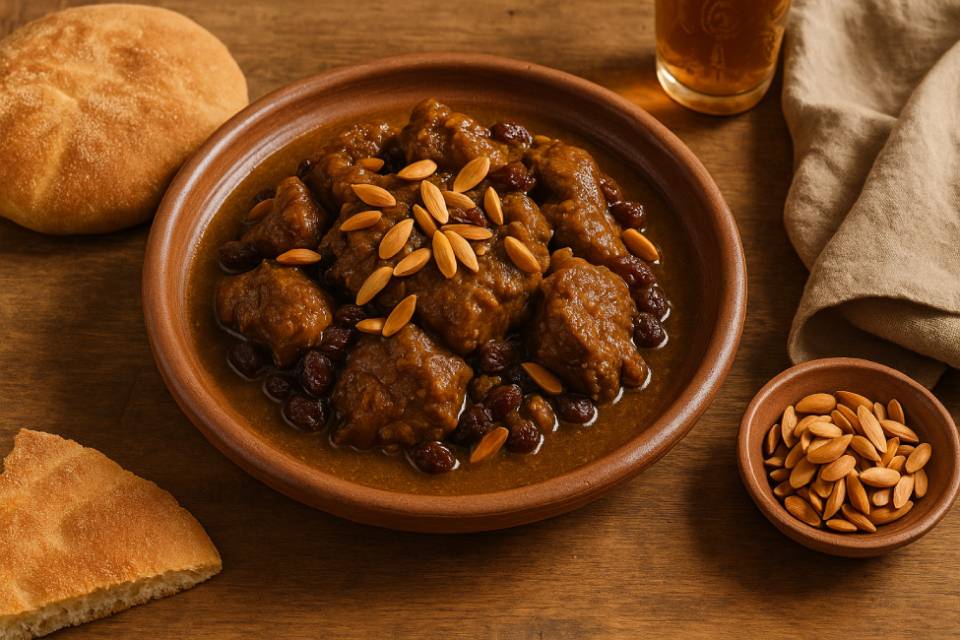
Table of Contents
🟫 Before We Begin: A Moment That Still Tastes Like Home
It was just after Eid al-Adha, one of those quiet Moroccan nights where the air feels slower. I had dropped off a group of tourists at a Riad in Fès, just doing my job, nothing more.
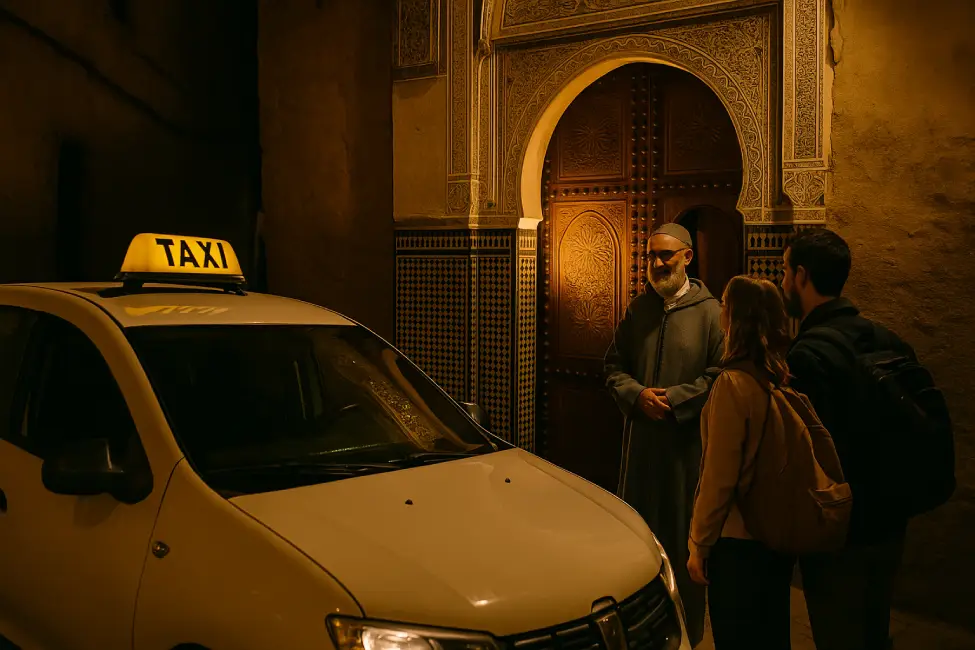
I was ready to head back. But the Riad owner, a calm man in a grey djellaba, looked at me and said,
“You’re not driving back. Stay. Eat first.”
It wasn’t a suggestion. It felt like something deeper, part of who we are.
So I stayed.
And that night, under lanterns and silence, he brought out Mrouzia. Tender lamb, sweet raisins, golden sauce, rich, comforting, and full of meaning.
I’d had Mrouzia before. But never like this.
That night, I wasn’t just a driver. I was welcomed. And that’s the version I want to share with you.
🟫 The Ultimate Mrouzia Recipe
Let’s not pretend: searching for a Mrouzia recipe usually means you’re chasing a memory, yours or someone else’s. Maybe you tasted it once, maybe your grandmother made it. Or maybe, like me, you stumbled into it on a night that didn’t go the way you planned.
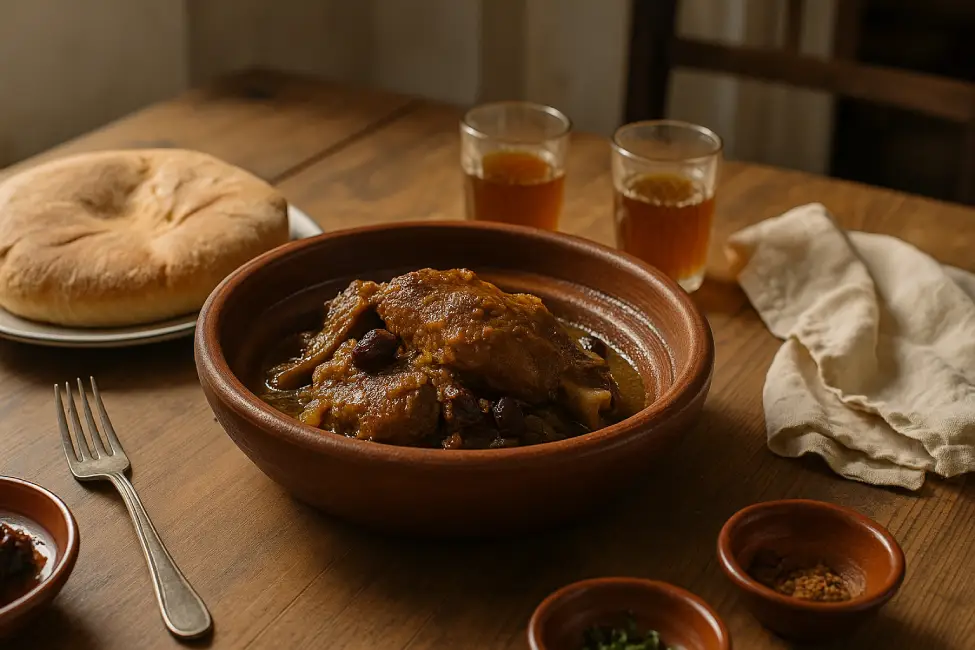
Mrouzia isn’t the kind of dish you just make on a random Tuesday. It comes with intention. Usually, a week after Eid al-Adha, when the lamb is no longer fresh but deeply respected, wrapped, marinated, preserved, waiting. That’s when this dish appears. Not out of necessity, but because it deserves to.
The version I’m sharing here has roots in something personal. One night in Fès, after dropping off clients at a riad, a quiet job, nothing unusual, I was offered a place to sleep. It was late. Too late to head back. I wasn’t expecting anything more than a mattress, but instead, I was served this: slow-cooked lamb, glistening with honey, soft raisins, a fragrance that stopped me mid-breath. And yes, I still remember the first bite.
Since then, I’ve tried to recreate that moment. Not just the taste, but the silence around the table. The generosity. The sense that someone, somewhere, spent hours on something just so you could feel welcome.
In this post, I’ll guide you through every detail, from selecting the right lamb to coaxing flavor from ras el hanout.
And if you enjoy soulful Moroccan dishes like this, Rfissa offers a different kind of depth, soft, fragrant, grounding.
For a trustworthy external reference on Eid al-Adha traditions and why dishes like Mrouzia emerge at this time, check out this deep dive on Taste of Maroc:
This guide is more than a recipe. It’s an offering, from a night in Fès, to your table.
🟫 What is Mrouzia?
You don’t just cook Mrouzia. You prepare it with a kind of quiet respect.
It’s not a meal you rush. There’s rhythm in how it comes together, the layering of spices, the slow bubbling of lamb, the way honey softens the broth just as the meat starts to fall apart. You stir, wait, adjust.
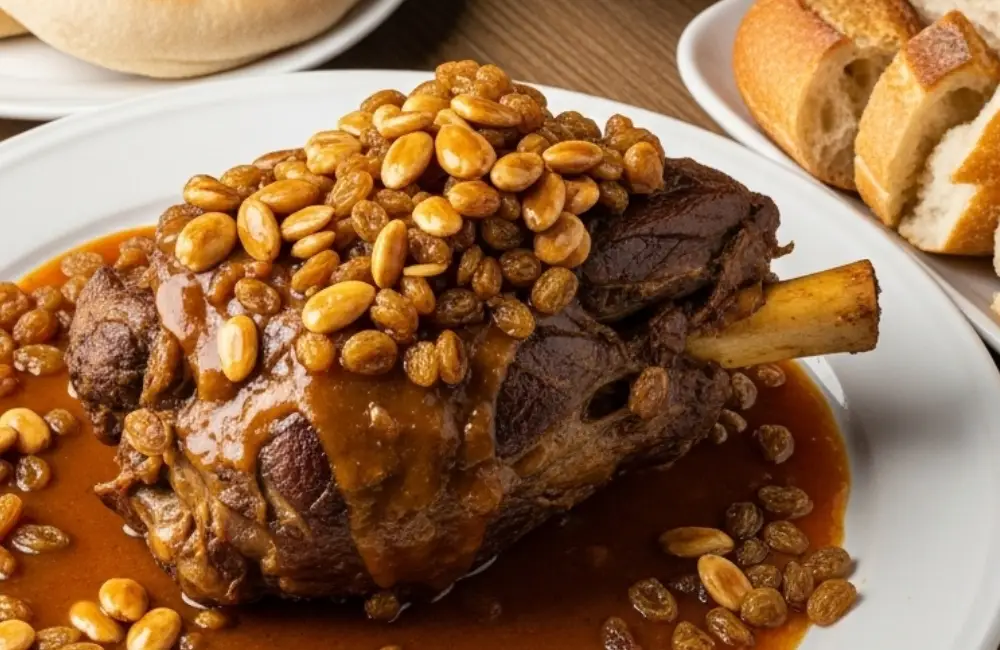
And at some point, the scent takes over the kitchen, warm, floral, earthy, sweet. That’s when you know.
Mrouzia usually comes to the table in the days after Eid al-Adha. Not the first day, not when everyone’s busy. But later, when things settle, the house smells like Smen and memory. It’s made from what remains of the lamb, yes. But there’s nothing “leftover” about it. It feels intentional. Sacred, even.
Before fridges and modern storage, Mrouzia was practical, too. The spices, the honey, the preserved butter, they weren’t just for flavor.
They protected the meat. Made it last. Some families stored it for weeks, tucked into clay jars in cool rooms. Not everyone still does that. But the instinct to make something last, something beautiful, that part stays.
If that feeling speaks to you, you’ll probably connect with this stuffed leg of lamb recipe as well. It’s another dish that turns care into flavor.
And if you’re wondering how Eid shapes dishes like this, not just religiously but emotionally, this Morocco World News piece is worth a quiet read.
🟫 A Taste of History – From Preservation to Celebration
We tend to think of preservation today as something mechanical, a fridge door, a sealed container, a timestamp. But in Morocco, before any of that, preservation was an art. And Mrouzia is one of its finest expressions.
Initially, this dish wasn’t made with the choicest cuts. After Eid al-Adha, families would look at what remained, bones, offcuts, anything too small to roast, and ask, “How do we make this last?” The answer came slowly: fat, honey, time, and spice. Cooked low, sealed with Smen, gently sweetened.
The result was a tagine that could sit at room temperature for days, sometimes longer, not just surviving, but improving with time.
In Fès, where culinary restraint and refinement go hand in hand, this method became something more. Over time, families began choosing better cuts for Mrouzia, not because they had to, but because they wanted to. What started as a clever way to stretch the sacrifice became a ritual of its own.
This same logic lives in other Moroccan traditions, like khlii, that rich, oily confit made from gueddid, or sun-dried meat strips steeped in spices and slow-cooked in fat. It’s preservation through patience. Preservation with purpose.
Suppose this kind of kitchen wisdom resonates with you. In that case, you might enjoy my Zesty Moroccan Meatballs, a dish that, while simpler, still carries the warmth of spice, depth, and balance.
For those curious about how traditional foods are being rediscovered and honored across the world, the Slow Food Foundation’s Ark of Taste catalogues endangered heritage recipes, including several Moroccan entries, reminding us that preservation isn’t just about meat. It’s about meaning.
🟫 Key Ingredients for Authentic Mrouzia
At the heart of any great Mrouzia is a quiet complexity. It’s not about fancy ingredients or overcomplication. Instead, it’s about how familiar elements, such as lamb, spices, and honey, come together in a way that feels almost ceremonial. Each part has a purpose. Each layer builds the next.
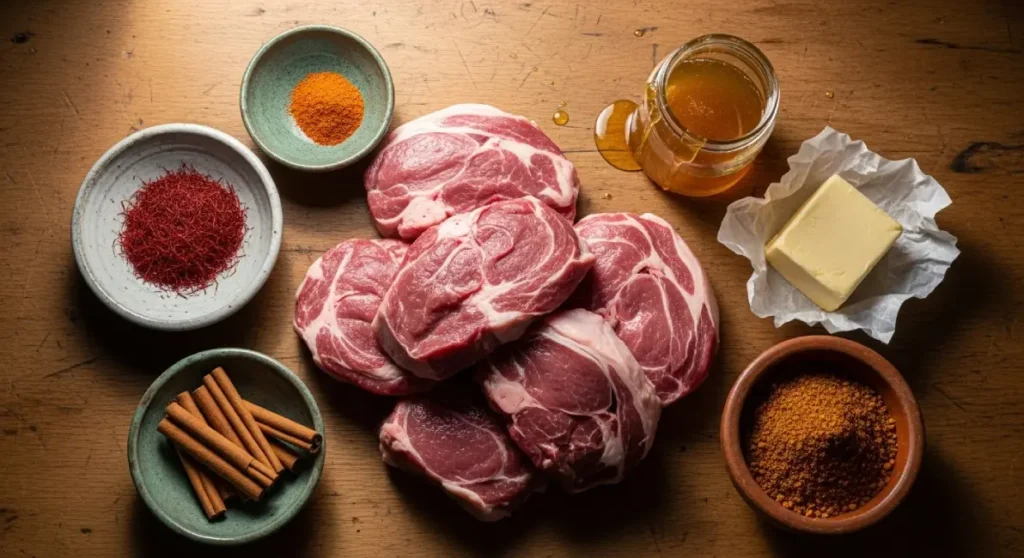
Let’s look at what makes this dish so distinct.
For the Lamb
The foundation of Mrouzia is the meat, and for good reason. Lamb shoulder or lamb shanks are the preferred cuts, and not just by tradition. They’re rich in connective tissue and fat, which means they soften beautifully with time, soaking up every bit of spice and sauce.
Some cooks use lamb neck, which is underrated but intensely flavorful. If you’re leaning toward beef instead, choose a slow-cooking cut like beef chuck, and be generous with your simmering time.
For the Sweet & Savory Sauce
Mrouzia is known for its rich, almost luxurious sauce, which is the perfect meeting point between sweet and spicy. It’s what makes this dish linger on the palate and in the memory.
You’ll need:
- Dark raisins, soaked to plump them up
- Honey, to add warmth and depth
- Saffron threads, for color and subtle perfume
- Cinnamon sticks, which simmer with the meat
- Ground ginger, a staple in Moroccan bases
- Onion, grated for a smoother texture
- Butter and smen, the latter being Morocco’s beloved aged clarified butter — sharp, earthy, and full of character.
- A little vegetable oil, to bind the flavors
It’s a sauce that thickens as it cooks, becoming glossy and clingy, the kind that glazes the meat just right.
The Star Spice: What is Ras el Hanout?
If Mrouzia had a soul, it would be ras el hanout. This isn’t just one spice, it’s a statement. The name means “head of the shop,” and it refers to a carefully curated blend, different in every region and family.
Common elements include:
- Cinnamon
- Cardamom
- Turmeric
- Nutmeg
- Cloves
- Sometimes dried rose petals or fennel.
A good ras el hanout is never too sharp or overwhelming, just layered, warming, and quietly complex. It’s the heart of many Moroccan tagines, including Mrouzia.
Suppose you’re curious to taste how this blend works in a totally different dish, try my Chicken with Apricots and Almonds. In that case, it carries some of the same notes in a softer, fruitier context.
And to understand how spice blends like ras el hanout shape world cuisines, check out this insightful article from National Geographic. It’s a reminder that even a spoonful of ground spice can carry centuries of culture.
🟫 How to Make Mrouzia Step-by-Step
I’ll be honest, Mrouzia isn’t the kind of dish you throw together at the last minute. But that’s what makes it special. When I prepare it, I always take my time. It’s slow food, rooted in tradition. And with each step, you feel the dish coming alive.
Let’s cook it together, just like I did that night in Fes, when the aroma filled the Riad’s kitchen and we all gathered around the table.
Begin with the Marinade
Start by preparing the spice rub. Mix ras el hanout with ground ginger, saffron threads, a little salt and black pepper, and enough water to make a smooth, fragrant paste.
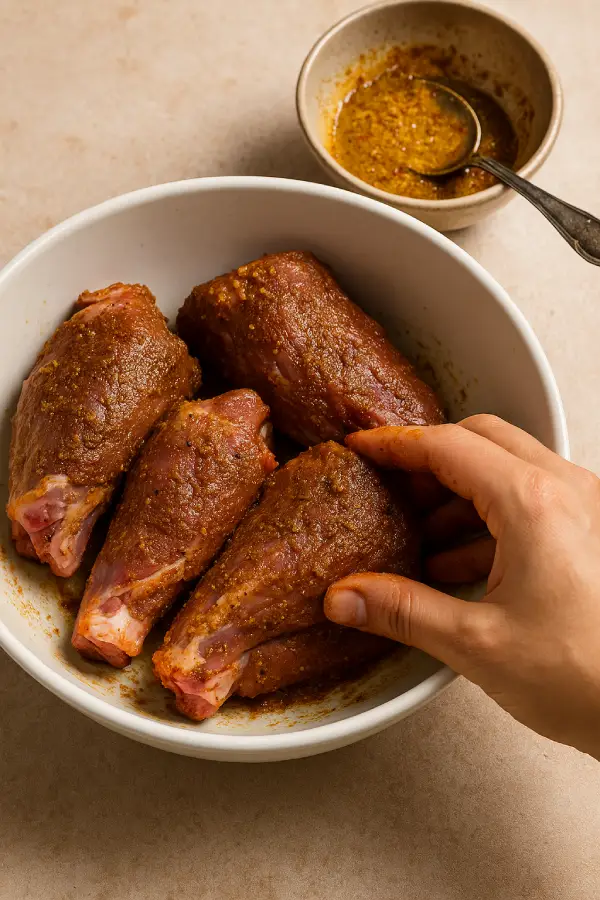
Take your lamb, shoulder, or shank, whichever is best, and massage that mixture into every piece. Be generous. Once done, cover it and let it rest in the fridge for a few hours.
Overnight is even better. The meat will soak up the spices and reward you later.
Build the Flavor Base
While the lamb rests, grate a large onion. Yes, great, it’s how we do it back home, so it melts right into the sauce. In your pot or tagine, warm a spoonful of vegetable oil with some butter and a bit of Smen, our Moroccan preserved butter.
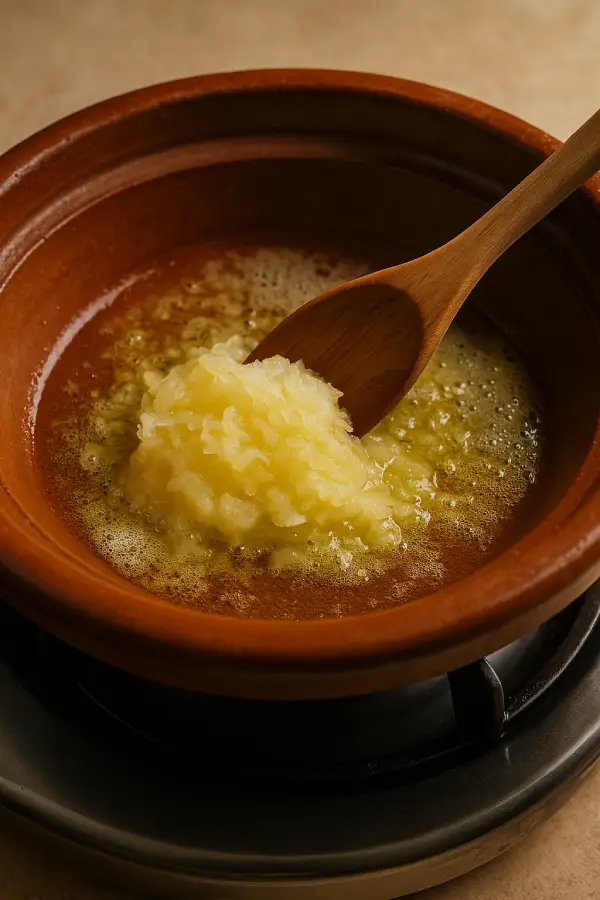
Add the onion and let it cook gently over medium heat until it softens and becomes fragrant. This is your foundation.
Sear the Meat Slowly
Now bring in your lamb. Add it to the pot and brown it lightly on all sides. You’re not trying to cook it through, just give it a bit of color and seal in the flavor.
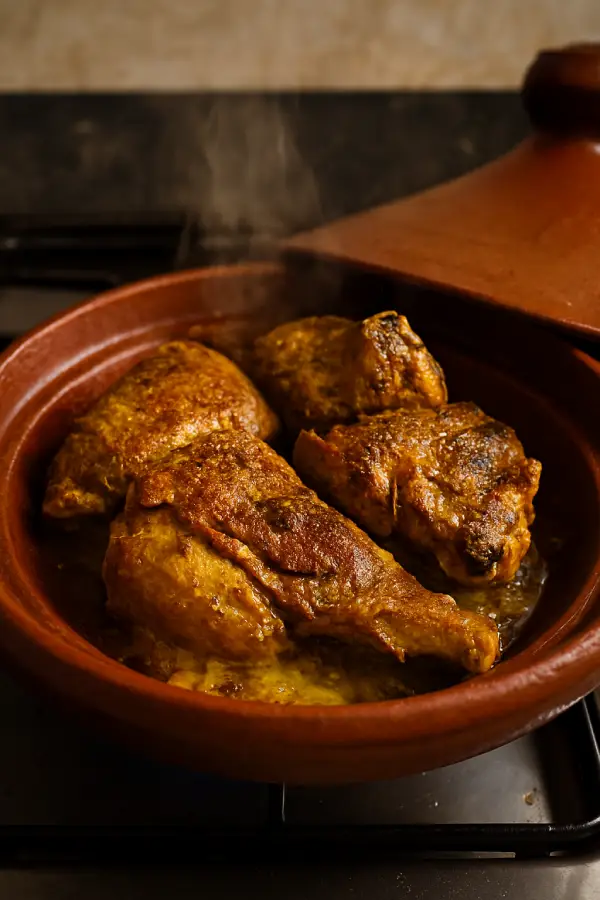
You’ll notice the smell changes already, more profound, warmer.
Let It Simmer in Spices
Add two cinnamon sticks, then pour in just enough hot water to cover the meat. Bring it to a simmer, cover loosely, and let it cook gently for up to two hours.
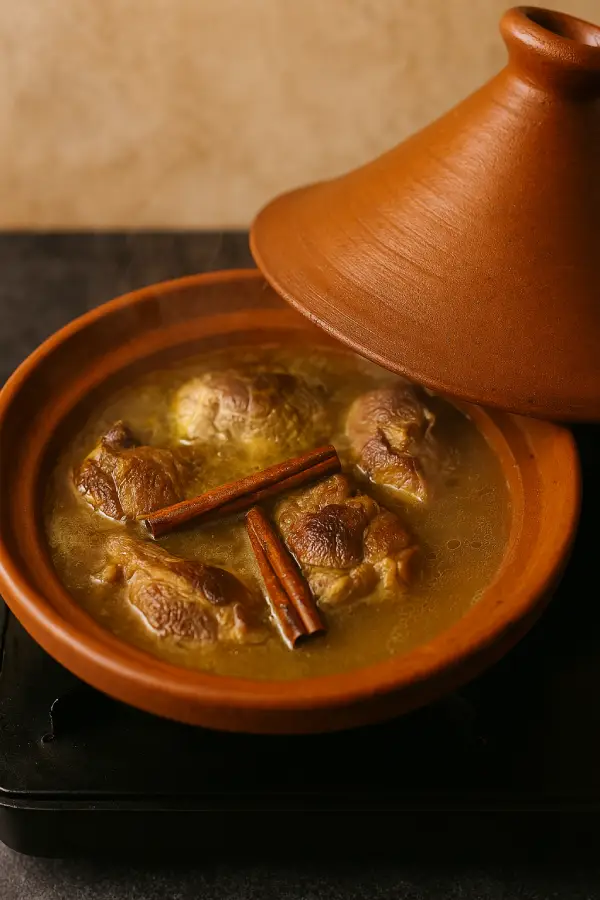
Don’t forget to check in every 20 to 30 minutes. Stir, taste, and add a little more water if needed.
This part takes time, but that’s what transforms the lamb into something meltingly tender.
Time to Sweeten
Once your lamb is beautifully soft, remove the cinnamon sticks. Drain your soaked raisins and add them in, then drizzle in the honey. Stir gently.
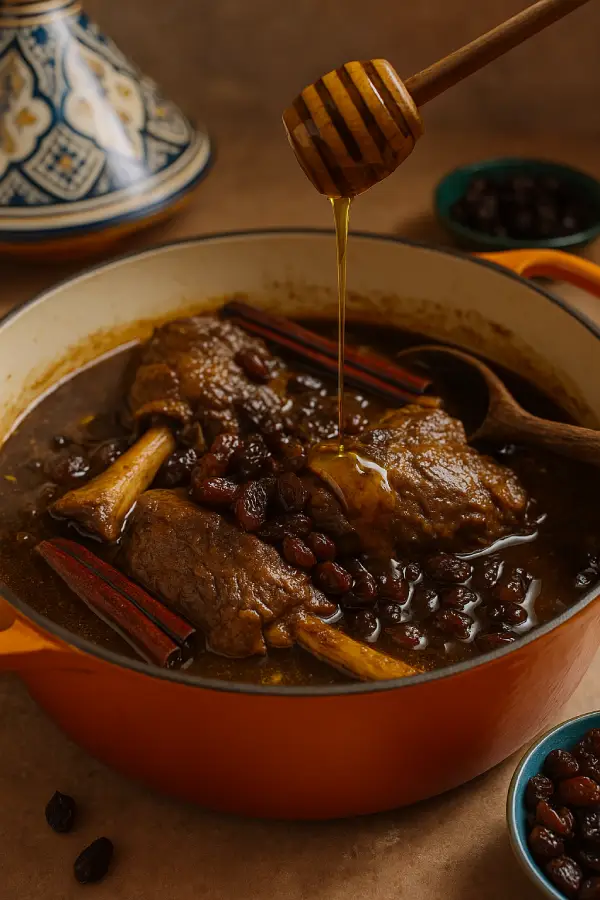
Now, leave the pot uncovered and let the sauce reduce. You’ll see it start to thicken and turn glossy. That’s when Mrouzia begins to shine.
When the Sauce Clings, You’re Done
After 10 or 15 minutes, the sauce should be just right, thick enough to coat the meat, but still smooth. Taste it. It should be sweet, savory, and deeply spiced all at once.
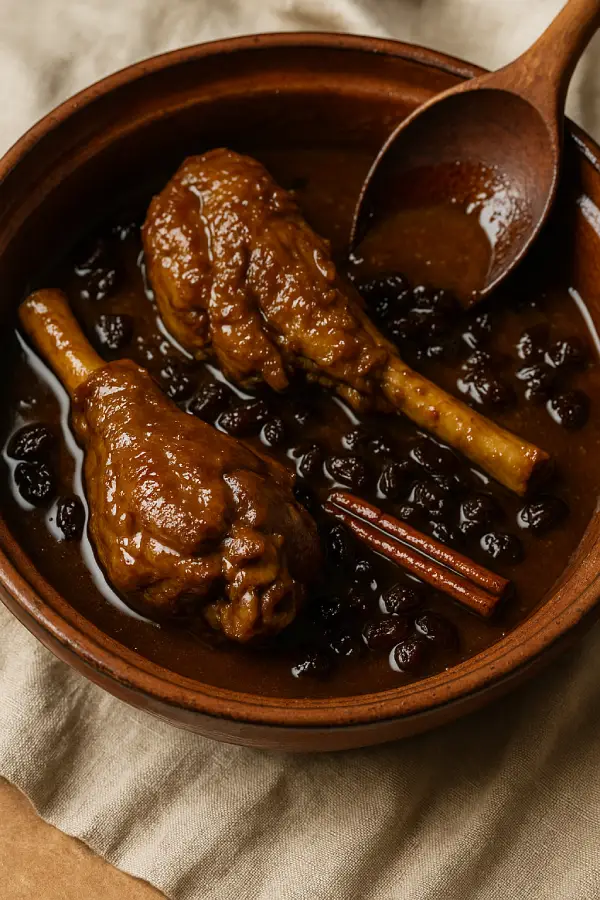
To serve, place the meat on a platter, top with the raisins, and spoon the sauce all around. Add some toasted almonds if you like, I always do. And don’t forget the bread. You’ll want something to scoop up every last drop.
This is more than just dinner. It’s a memory on a plate.
🟫 Pro Tips & Recipe Variations
There’s no one way to make Mrouzia. Over the years, I’ve learned that each cook brings a little something different to it.
Below are just a few tips and tweaks I’ve picked up from experience, nothing fancy, just minor details that might make your dish even better.
Choosing the Best Cut of Lamb
I always go for lamb shoulder. It’s fatty in the best way, locking in moisture and making every bite melt. Lamb shanks work too; they look great when served and fall apart nicely after slow cooking.
If you’re wondering about boneless versus bone-in, boneless is easier to eat. Still, bone-in gives a deeper flavor to the sauce. For family dinners, I usually stick with shoulder, bone and all. It’s what my mother used to.
Can I Make Mrouzia with Beef?
Yes, and I’ve done it plenty of times. When lamb isn’t available, or if someone prefers beef, I go with beef chuck. It’s affordable, easy to find, and holds up well in long cooking. You’ll just need to give it a little extra time to get tender.
If you enjoy rich beef tagines, you might also like my Beef Tagine with Artichokes and Fava Beans. It’s simple, comforting, and perfect for chilly evenings.
Don’t Have a Tagine Pot?
No stress. A tagine is lovely, yes, but you don’t need one to make a good Mrouzia. I often use a heavy-bottomed Dutch oven or a thick cooking pot. As long as the lid holds in the steam and the heat is gentle, you’re good to go.
Regional & Cultural Twists
Like many Moroccan dishes, Mrouzia has its own local stories. In Qasbat Tadla, some cooks add a touch of cumin to the spice mix, just enough to give it depth without overpowering the sweetness.
In the north, there’s a version called tahlia, where instead of raisins, they use raisin juice. It gives the sauce a silky finish that’s lighter but still festive.
If you’re curious about how Moroccan food changes from city to city — how couscous in Marrakech tastes different from tagines in the Atlas, this article from Serious Eats paints a vivid picture of regional flavors and local traditions.
🟫 How to Serve, Store, and Reheat Mrouzia
After all the time and care you’ve put into cooking Mrouzia, it deserves to be enjoyed in all its glory. Let me walk you through how I like to serve it, and what to do if you have leftovers (which, honestly, are a gift the next day).
Perfect Pairings & Serving Suggestions
Of course, you can serve Mrouzia with Moroccan khobz, the kind you tear by hand, warm and slightly crispy. But when I want to make it more of a feast, I like to add steamed couscous, soft and fluffy, it soaks up that syrupy sauce beautifully.
To lighten the richness a bit, I always serve a fresh side salad: chopped cucumber, tomato, and red onion, dressed in lemon juice, olive oil, and some herbs. Simple, refreshing, and it brings everything into balance.
And please, don’t skip the mint tea. A glass after the meal helps you digest and just feels right. It’s like the punctuation mark at the end of a good story.
For another sweet-and-savory experience, try this comforting Chicken with Chickpeas and Raisins, it’s perfect for weeknights or casual gatherings.
Storing and Freezing
Mrouzia is one of those dishes that tastes even better the next day, once the spices have had time to settle and mingle.
- To store: Let it cool, then put it in an airtight container. It’ll keep in the fridge for up to 4 days.
- To freeze: It holds up great in the freezer. Just portion it out into sealed containers, label them, and freeze for up to 3 months.
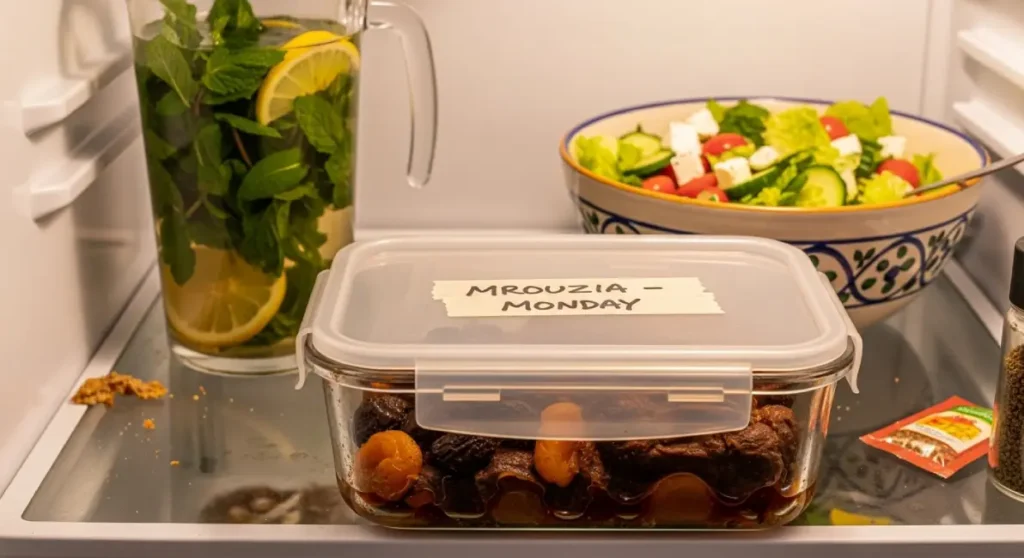
Tip: freeze it in small batches so you can thaw only what you need.
The Best Way to Reheat
To keep the sauce smooth and the meat tender, reheat slowly on the stovetop. I usually add just a splash of water or broth to help loosen the sauce. Keep the heat low, no rushing.
Avoid the microwave if you can. It’s quick, yes, but it tends to dry out the lamb and can mess with the sauce texture.
For more insight into how Morocco is preserving its rich culinary traditions, this article from Morocco World News shares a look at a new UNESCO-backed project dedicated to Moroccan food heritage.
🟫 Frequently Asked Questions (FAQ)
What does Mrouzia taste like?
If I had to describe it in one word, I’d say: rich. The lamb is so tender it falls off the bone, and the sauce is thick and glossy, sweet from the honey and raisins, but grounded with warm spices. It’s not dessert-sweet, don’t worry. It’s just perfectly balanced.
Is Mrouzia spicy?
Nope, not in the “hot” sense. It’s full of spices, yes, but think cinnamon, saffron, ginger… not chili. Even people who don’t usually like spice love Mrouzia. It’s warm, not fiery.
What makes Mrouzia different from other tagines?
Most Moroccan tagines are savory, think preserved lemons, green olives, or root vegetables. But Mrouzia takes a different path. It’s sweet, deeply spiced, and meant for special occasions like Eid al-Adha.
The honey and raisins give it that festive warmth. It’s the opposite of something like Chicken Tagine with Potatoes and Olives, which is bright and tangy, while Mrouzia feels mellow, rich, and indulgent.
Can I make Mrouzia without honey?
Yes, you can. I’ve had people try it with maple syrup or a small spoon of sugar. It’s not quite the same, but it still brings out that sweet note. Just make sure not to skip the raisins, they’re key to the flavor.
How long can I keep Mrouzia?
If there’s any left, that is! In the fridge, it’ll last around four days. And you can freeze it, too, for up to three months. Just reheat slowly, with a splash of water or broth, and it’ll come back just like new.
🧾 Conclusion
Look, when I make Mrouzia, it’s never just food. It’s a piece of home, hours of stirring and slow heat, the smell of spices that hang in the air like memory.
You don’t rush it. You don’t micromanage it. You let it simmer. You walk away. You come back. And the lamb? It softens. The sauce? It turns syrupy and golden.
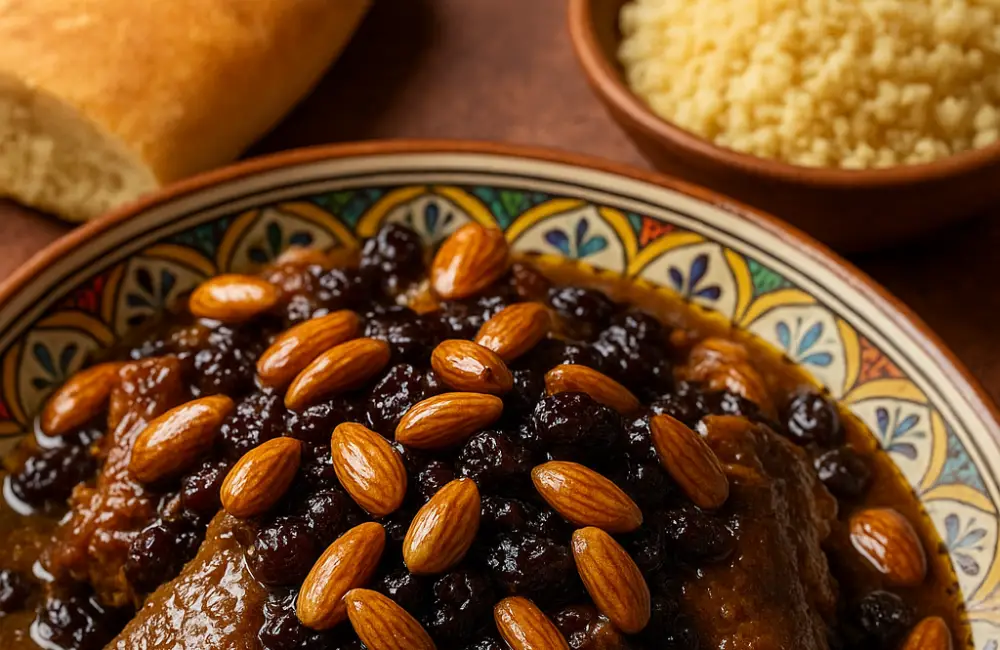
If you tried it, congrats. You just made something more than a meal.
👉 Leave a quick comment or rating below. Seriously. I’d be honored to see how your version came out.
Want to discover more? You can find all my Moroccan recipes here, from cozy tagines to festive dishes.”
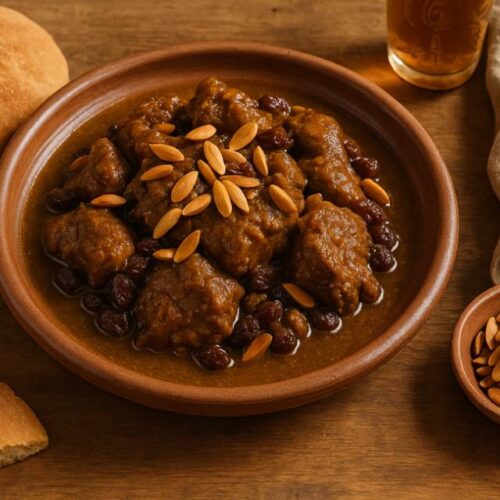
Mrouzia recipe: Authentic Moroccan Lamb with Raisins and Honey
Ingredients
For the Lamb Marinade:
- 2.2 lb 1 kg lamb shoulder or shank, cut into chunks
- 1 tbsp ras el hanout
- 1 tsp ground ginger
- A generous pinch of saffron threads crumbled
- Salt and black pepper to taste
- 2 tbsp water
For the Sauce:
- 1 large onion grated
- 1 tbsp vegetable oil
- 1 tbsp unsalted butter
- 1 tsp smen Moroccan preserved butter – optional
- 2 cinnamon sticks
- 1.5 cups 200 g dark raisins, soaked in warm water
- 1/4 cup 60 ml honey
- Hot water enough to cover the meat
Optional Garnish:
- A handful of blanched almonds fried or toasted until golden
Instructions
👨🍳 Instructions
- Marinate the Lamb: In a bowl, mix ras el hanout, ginger, saffron, salt, pepper, and water into a paste. Rub it all over the lamb pieces. Cover and refrigerate for a few hours or overnight.
- Prepare the Base: In a large pot or tagine, heat the oil, butter, and smen. Add the grated onion and cook for 3–4 minutes over medium heat until soft.
- Sear the Lamb: Add the marinated lamb to the pot. Give it a good color by turning it every so often, five minutes is usually enough.
- Simmer Gently: Add the cinnamon sticks and pour enough hot water to cover the meat. Bring to a simmer. Cover and cook for 1.5 to 2 hours, checking and stirring occasionally. Add more water if needed.
- Sweeten the Tagine: When the meat is fork-tender, remove the cinnamon sticks. Add the soaked and drained raisins along with the honey.
- Reduce the Sauce: Let it simmer uncovered for another 10–15 minutes until the sauce thickens into a syrupy glaze.
- Serve: Arrange the lamb on a serving plate, top with the raisins and sauce, and garnish with toasted almonds if desired. Serve hot with Moroccan bread or couscous.
Notes
- Toast your almonds just before serving for the best crunch and aroma.
- You can use beef chuck if lamb isn’t available, though cooking time may vary slightly.
- Using smen is optional, but it adds a deep, aged flavor traditional to Moroccan dishes.
🔍 Nutrition Information (Per Serving – Approximate)
A Note on Nutrition
I am a cook, a storyteller, not a man with a white coat and a laboratory. The numbers you see below are an honest estimate, calculated with an online tool. They are a good guide to help you understand the plate in front of you.
| Nutrient | Amount |
|---|---|
| Calories | 480 kcal |
| Protein | 28 g |
| Carbohydrates | 30 g |
| Fat | 28 g |
| Sugar | 16 g |
| Fiber | 3 g |
| Sodium | 540 mg |
🧾 Glossary of Moroccan Culinary Terms for Readers
| Term | Explanation |
|---|---|
| Mrouzia | A traditional Moroccan lamb tagine with honey, raisins, and ras el hanout, typically made during Eid al-Adha. |
| Eid al-Adha | A major Islamic holiday celebrated with traditional Moroccan recipes like Mrouzia, involving lamb dishes. |
| Riad | A traditional Moroccan house often used as a guesthouse, especially in old cities like Fès. |
| Fassi | Refers to someone from Fès, a Moroccan city famous for its culinary refinement and historic tagines. |
| Djellaba | A traditional Moroccan robe often worn during religious festivals and family meals, including Eid feasts. |
| Smen | A fermented Moroccan butter used in many tagine recipes, known for its earthy, aged flavor. |
| Ras el hanout | A rich Moroccan spice blend used in tagines and stews, meaning “top of the shop”, unique to each region. |
| Tagine | A slow-cooked Moroccan dish and also the earthenware pot it’s cooked in—essential to traditional cuisine. |
| Khlii | A Moroccan preserved meat confit, made with spices and fat, often used in traditional breakfast dishes. |
| Gueddid | Sun-dried Moroccan meat strips, usually lamb or beef, used in rural preservation methods. |
| Khobz | A round, crusty Moroccan bread, ideal for scooping up sauces from tagines like Mrouzia. |
| Tahlia | A Northern Moroccan version of Mrouzia where raisin juice replaces whole raisins for a smooth, festive sauce. |
| Qasbat Tadla | A region in Morocco known for local spice variations in tagines, including a touch of cumin in Mrouzia. |
📲 Follow Us on Social Media
Want more authentic Moroccan recipes, cooking tips, and Eid memories?
Join us on social media! Follow us on Facebook, Instagram, YouTube, and Pinterest to stay inspired, and don’t forget to share your own version of Mrouzia with our community.
📨 Stay Connected to Authentic Moroccan Cooking
Don’t miss a single recipe! From festive dishes like Mrouzia to everyday Moroccan favorites, our newsletter brings you the rich flavors of Morocco, right to your inbox.
📬 Subscribe now and get weekly inspiration, cooking tips, and traditional secrets straight from our kitchen to yours.
📩 Join Our Moroccan Foodie Community
Get the best Moroccan tagine recipes and seasonal culinary tips straight to your inbox.
💬 Share Your Thoughts!
Have you tried this Mrouzia recipe? ✨
Let us know how it turned out, share your own twist, or ask any questions in the comments below.
We love hearing from you, and your feedback helps others exploring Moroccan cooking too!
